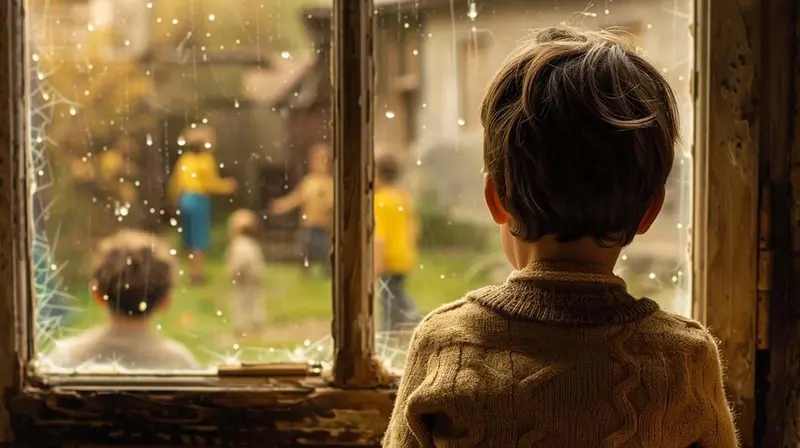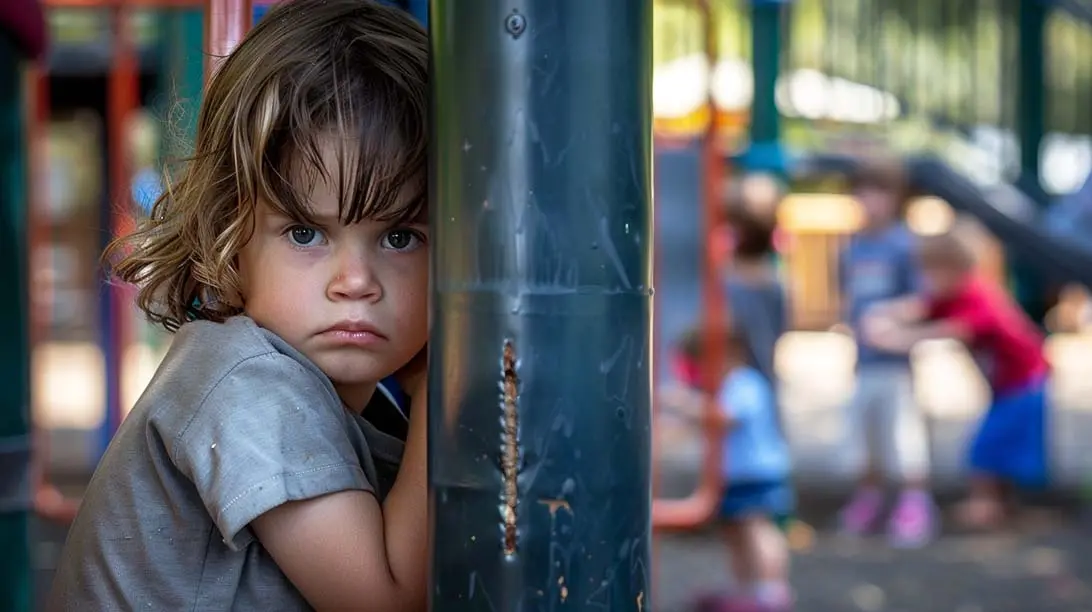Decoding ‘shyness in kids’ can be tricky. Is your child naturally introverted, or could their quietness hint at social anxiety? This article clarifies the distinction and guides you through supportive steps to encourage your child’s social confidence, without weighing you down with jargon or unnecessary details.
Key Takeaways
- Childhood shyness is a temporary trait that can ease with familiarity, whereas social anxiety disorder is a persistent clinical condition leading to avoidance and distress in social interactions.
- Both biological factors, like genetics and brain structure, and environmental influences, such as family dynamics, socioeconomic status, and experiences like bullying, contribute to a child’s likelihood of developing shyness or social anxiety disorder.
- Strategies to support children with social challenges include gradual exposure to social settings, role-playing, skill development, and collaboration between parents and educators, with professional therapy as an option when interventions at home and school don’t suffice.
Introduction to Childhood Social Challenges

Childhood is a kaleidoscope of experiences, brimming with opportunities to interact with the world. For some children, social situations are a playground, a chance to connect with other children and express themselves. Yet, for others, these encounters with other kids can feel challenging, or even intimidating.
Shyness and social anxiety often get interchanged in conversation. However, it’s essential to differentiate between the two. Shyness is a personality trait, often manifesting as a hesitance during initial interactions, but eventually ebbing away as comfort levels increase. On the other hand, social anxiety disorder is a clinical condition marked by intense fear and avoidance of social interactions.
The impact of these behaviors on a child’s development can vary significantly. A shy child might take more time to warm up to new people or situations, whereas a child with social anxiety might consistently avoid such scenarios, impacting their ability to form social relationships.
Understanding the intricacies of these behaviors lays the foundation for nurturing children’s social skills, thereby helping them navigate the challenges of early adolescence and beyond.
Biological and Environmental Influences

The dance between nature and nurture shapes us all. From our eye color to our affinity for certain foods, our genes play a significant role. However, our environment also leaves an indelible mark on our behaviors and attitudes, including our comfort levels in social situations.
Research has shown that gender differences in anxiety disorders are marked, with females showing an increased risk during adolescence. However, biological factors such as cortisol levels, heart rate, and blood pressure were not found to be significant predictors. Instead, social anxiety disorder often arises from a complex interplay of genetics and environment, with potential origins in family history and learned behaviors.
Biological Influences on Childhood Behavior
Genetics can predispose children to shyness, with 15-20% showing inherent temperamental traits that manifest as reserved or timid behaviors. It’s like they’ve inherited a tendency towards caution in social situations. But that’s not the whole story. Genetics might load the gun, but it’s the experiences that pull the trigger.
Despite genetic influences, individual experiences significantly shape a child’s social comfort levels. A child’s ability to regulate behavior and attention, known as effortful control, and its subcomponent, attentional control, are related to the risk of developing specific phobia. Temperamental frustration and low effortful control in preadolescence have been identified as predictors for anxiety disorders in late adolescence.
A child’s environment, including their family dynamics, can influence these experiences. Parental depression and anxiety have been found to increase the risk of developing anxiety disorders in offspring, albeit less than initially hypothesized in previous studies.
Research also suggests that a brain structure known as the amygdala might be involved in social anxiety, with an overactive amygdala possibly leading to a heightened fear response in social situations.
The Impact of Environment
While genetics play a role, the environment in which a child grows up also leaves a lasting impact on their social behavior. Family dynamics, including parenting styles and family interactions, significantly contribute to developing either shyness or confidence in social situations. The way parents behave in social settings acts as a model for children to learn from. Higher socioeconomic status has been suggested to slightly reduce the risk of anxiety disorder, particularly in girls. However, negative experiences, such as bullying or humiliation, along with overprotective or controlling parenting, may contribute to the development of social anxiety disorder in children. It’s like these experiences create a lens through which the child perceives the world, coloring their interactions and potentially leading to anxiety.
In this journey of understanding, we’ve explored how a child’s biology and environment could influence their behavior. But how can we differentiate between a shy child and a child with social anxiety? Let’s delve into that next.
Recognizing Signs of Shyness vs. Anxiety

Being able to recognize the signs of shyness versus social anxiety can make a world of difference in understanding and supporting a child. It’s like being able to read the road signs on a journey, guiding you in the right direction.
Shyness can manifest as:
- Nervousness in new social settings, like a shy baby
- Clinging to a parent in the presence of strangers
- Preferring smaller groups and being hesitant in social participation
However, once a shy person warms up to the environment and the people, they’re usually able to interact comfortably.
On the other hand, social anxiety goes beyond initial hesitation. It includes severe avoidance and distress in social situations. The anxiety provoking situations might range from:
- speaking in public
- eating in the presence of others
- participating in group activities
- making eye contact
- initiating conversations
This fear and avoidance significantly impact the child’s overall functioning, often leading to functional impairment.
Recognizing these signs is just the first step. The next is learning how to support children who exhibit these behaviors, helping them build confidence and navigate social situations with ease.
Strategies for Supporting Children

Supporting a child with shyness or social anxiety goes beyond simply telling them not to be shy. It involves a thoughtful approach, understanding their fears, and gently guiding them towards overcoming their challenges.
Parents can help their children deal with mild shyness by avoiding labeling them as ‘shy’, not allowing others to label them, and by not criticizing or mocking them for their shyness. Let’s delve into some specific strategies to encourage positive social engagement and develop skills for social situations.
Encouraging Positive Social Engagement
Encouraging positive social interaction is like teaching a child to swim. You start in the shallow end and gradually venture into deeper waters as their confidence grows, following helpful tips along the way.
Gradual exposure therapy involves slowly introducing children to social situations to build confidence and social skills. It could be as simple as encouraging a conversation with a new friend or participating in a group activity. Alongside exposure, role-playing games can help children rehearse social interactions in a safe environment, preparing them for real-world scenarios.
Parents and caregivers can support children by validating their anxiety without reinforcing avoidance, and by expressing confidence in the child’s ability to cope through stressful situations. It’s about creating a balance between acknowledging their fears and encouraging them to face these challenges.
Skill Development for Social Situations
Developing social skills is like learning a new language. It involves understanding the basic rules, practicing, and gradually becoming fluent. Foundational skills such as eye contact, polite language, and understanding non-verbal cues can go a long way in helping a child engage in social situations. Building resilience is equally important. Exposing children to manageable stress and positive role modeling can foster resilience, preparing them to navigate life’s ups and downs.
Professional help such as stress management, relaxation strategies, counseling, and social skills training may be required for children with severe shyness. Therapists can help children learn to tolerate distress in social situations and reframe unhelpful thinking patterns.
The Crucial Role of Educational Settings

Schools are more than just centers for academic learning. They are pivotal in fostering social skills, self-esteem, and resilience. Teachers, with their unique position, can play a significant role in supporting shy or anxious students.
Teachers can assist shy students through non-verbal communication, positive reinforcement, and tailored participation methods. A simple thumbs-up or a nod from a teacher can boost a shy student’s confidence. Tailoring classroom participation, such as allowing shy students to present in front of a smaller group or giving them time to prepare, can also help.
Creating an inclusive classroom environment is equally important. A safe space where all students, particularly those who are shy or anxious, feel included and valued can help them thrive. From incorporating diverse learning styles to promoting empathy and respect, there are multiple ways of making classrooms more inclusive.
Collaboration Between School and Home

The journey of supporting children with shyness or social anxiety is not one that parents or educators have to undertake alone. Like a relay race, it requires joint efforts and seamless handoffs between school and home. Cooperation between parents and educators is critical in understanding and supporting children with shyness or anxiety.
Sharing insights about a child’s behavior, challenges, and strengths can help both parties better understand the child and tailor their support strategies. Developing customized approaches that consider the individual child’s needs and strengths can be highly beneficial. It might involve adjusting classroom participation methods, providing additional support at home, or even seeking professional help.
Indicators for Seeking Professional Help
Sometimes, despite the best efforts, a child’s shyness or anxiety might persist, affecting their overall functioning. It might be time to consider seeking professional help. But how do you know when it’s time?
Guidelines for identifying when a child’s shyness or anxiety requires professional attention can vary. However, if the child’s behavior significantly inhibits their social interactions, leads to intense distress, or persists over an extended period, it might be an indicator for seeking professional help.
Moreover, if the child’s separation anxiety leads to other issues like depression or significantly impacts their academic performance, it’s advisable to seek professional help. The good news is, effective interventions are available.
Cognitive Behavioral Therapy (CBT), also known as cognitive therapy, and group therapy are among the effective interventions for children struggling significantly with social interactions. These therapeutic options aim at helping children understand and manage their thoughts and feelings, thereby improving their coping mechanisms in social situations.
Summary
From understanding the spectrum of shyness to anxiety, examining the biological and environmental influences, recognizing the signs, and exploring strategies for support, we’ve journeyed through various aspects of childhood social challenges. We’ve delved into the roles of parents, teachers, and professionals in this journey, emphasizing the collaborative nature of this support.
Childhood shyness and social anxiety, though challenging, are not insurmountable hurdles. With understanding, patience, and the right support, every child can navigate social interactions with confidence. Remember, the journey of a thousand miles begins with a single step, and every small step towards overcoming shyness or managing social anxiety is a significant stride towards a confident and resilient child.
Frequently Asked Questions

At what age does shyness go away?
Shyness typically goes away for most children by the age of 2.
What causes shyness in a child?
Shyness in a child can be caused by personality traits and learned behavior, such as being emotionally sensitive or imitating shy role models like their parents. It's important for parents to be aware of their own behavior and set a confident example for their children.
What is the difference between shyness and social anxiety in children?
Shyness in children is usually temporary and eases with familiarity, while social anxiety is a clinical condition marked by intense fear and avoidance of social interactions, significantly impacting the child's overall functioning.
How do genetics and environment influence a child's social behavior?
Genetics can make children more prone to shyness, but how they are raised and their experiences play a big role in shaping their social behavior. Family dynamics, parenting styles, and personal experiences all have a significant impact on a child's comfort levels.
How can I support a child with shyness or social anxiety?
You can support a child with shyness or social anxiety by gradually exposing them to social situations, engaging in role-playing games, and teaching basic social skills. It's important to validate their feelings, avoid labeling them, and praise their efforts. In more severe cases, seeking professional help might be necessary.
